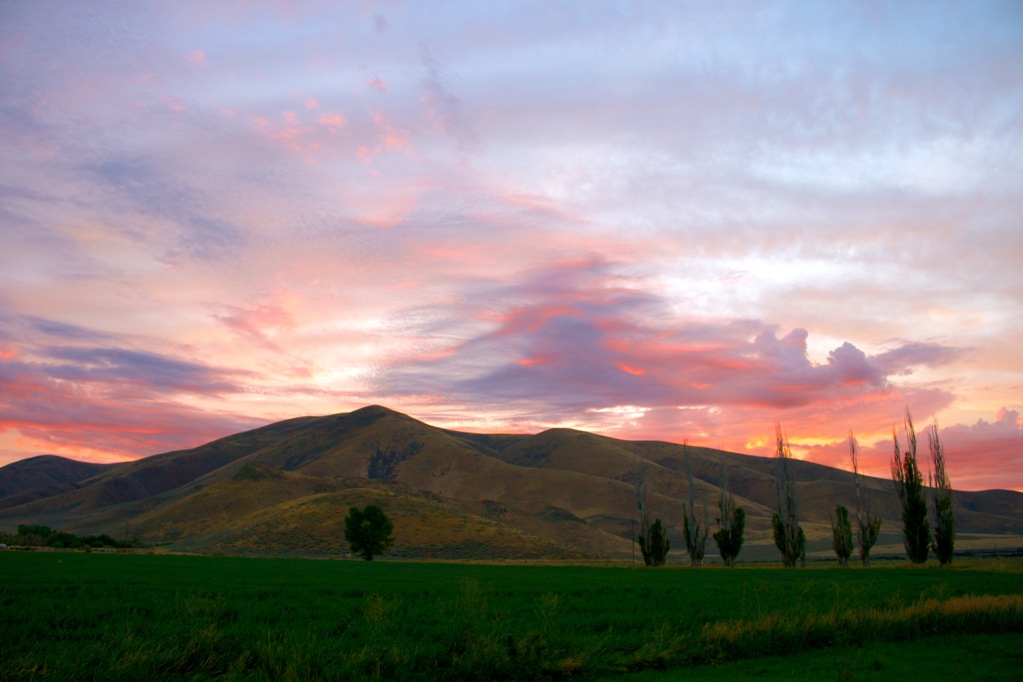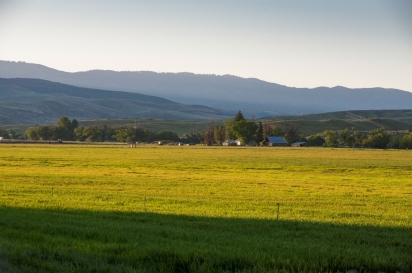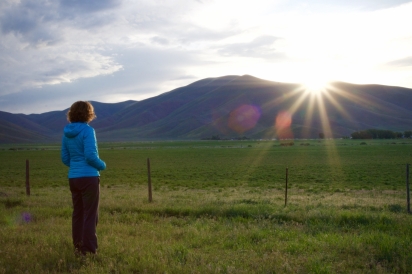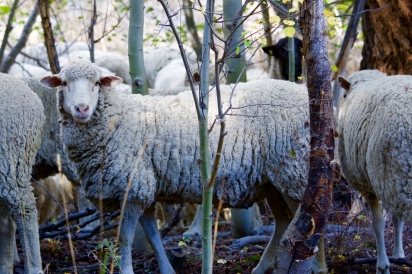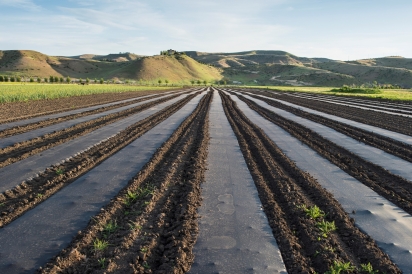LIKE OPEN SPACE? KEEP IT THAT WAY: Land conservation efforts lie in the hands of the farmer
Kathleen Bean sees wilderness and wildlife when she clocks in at the office. And she wants it to stay that way.
Bean’s office isn’t your typical fluorescent-lit box and she doesn’t need to look at a clock to tell the time of day. The Lava Lake Lamb co-owner and sheep rancher works under the sun and the sprawling high desert decorates her work space in hues of sand and sage.
She lives and works in a landscape that makes Idaho, Idaho, the Pioneer Mountains southeast of Sun Valley. And from there, she feeds America.
“It’s really a privilege to help steward this area,” the rancher said of the South Central Idaho landscape that nurtures the lamb she takes to market. And for the
price of a lamb dinner, consumers can help Bean ensure that the landscape she tends remains unspoiled by the scarring, depletion and degradation of development.
“The landowners are really committed to the land and they want to see it stay in production. Most of the people I work with are ranchers and farmers first but
they also care about the land,” said Lou Lunte, deputy state director of the Idaho chapter of The Nature Conservancy.
“Land owners are great stewards of the land. We can’t afford to own and manage the land. And there’s no reason. In a state like Idaho, where there’s so much public land already, I think the real need is to work with the private farmers and ranchers to help them find ways to keep producing food and conserving open space and wildlife and fish habitat,” Lunte said.
The landscape Bean tends brims with rich agricultural resources, productive rangeland and wild spaces. It’s the kind of place you’d want to put
on an Idaho postcard if you wanted more people to move to Idaho.
But the postcards got out and so did the Idaho secret. An evergrowing love for the Gem State puts agricultural and rangeland landscapes like the Beans’ under increasing threat from growth and development. And food advocates say that not only affects ranchers’ and farmers’ abilities to steward the land for future generations, but it affects everything from your viewshed to water quality and soil integrity to wildlife habitat and where you get your food.
“Many people have moved to Boise because of the open spaces and the wildlife and the fishing. We wouldn’t have that without the critical role that ranchers and farmers are playing,” Lunte said.
A love for Idaho has newcomers moving to the state at a rate of 30,000 a year, making the Gem State third in the nation in terms of largest growth rate, according to recent census data. The newcomers need somewhere to live and many find themselves in newly spawned residential developments that consume massive chunks of formerly productive agricultural land. That kind of development replaces agriculture supported habitat, wildlife corridors and free flowing water with cultivated grass monocultures, sprinkler systems and asphalt.
“We’ve paved paradise and put up a parking lot,” said Boise Foothills landowner Marian Shaw. And those parking lots have consequences that
reach beyond an environmental impact to our dinner tables.”
“Once farmland is gone, there’s no getting it back,” added Susan Medlin, co-founder and treasurer of the Treasure Valley Food Collection. “It takes thousands of years to create topsoil.”
Bulldozers, new construction, residential-area roads and the concrete, asphalt and lawns that come with it can undo thousands of years of mother nature’s work—work that blanketed southern Idaho with nutrient-rich sediment from historical floods and deposits of fertile volcanic
ash.
That topsoil does so much more than cover the Earth, said Josie Erskine, district manager of the Ada County Soil and Water Conservation
District (and co-founder of Peaceful Belly Farm). It filters water, prevents erosion and even cleans the air, she said. But every year, Idaho
loses vast acres of nature’s natural filter.
The state’s booming population growth leaves its mark on the Idaho landscape. Custom estates dot wildlife wintering areas that only agriculture touched for generations, and the residential edge of Idaho’s largest metropolitan area stretches even farther into the Boise Foothills each year. Much of Idaho’s growth consumes historic agricultural areas, and that has conservationists looking for new tools to help ranchers and farmers keep their land out of the hands of developers so they can protect it in the same way many of their families have for generations.
But it’s getting harder and harder for families to hold on to the family farm, said Tom Daniels, a land use and environmental planning professor at the University of Pennsylvania. He said competition from industrial farming leaves family farmers with few choices beyond selling the land to developers when a need for cash arises from stagnating commodity prices, college-bound children and looming retirements that reshuffle family budgets. That, combined with booming population growth has heightened conservation and farming advocates’ concerns over the resulting loss of farmland in Idaho and has them looking for more ways to help keep family farms intact.
Between 1982 and 2012, approximately 24.5 million acres of agricultural land was lost in the United States to residential development, mini malls, tracks of asphalt and all the trappings of suburban sprawl, according to the Farmland Information Center. And the Ada Soil and Water Conservation District reports that Ada County alone lost more than 100,000 acres to urban sprawl since 1975.
The consequences of agricultural land depletion got members of the Treasure Valley Food Coalition thinking about solutions that would not only conserve the land and all its environmental benefits, but also ensure a future of local food production and access. Their thinking inspired a coalition-led public conversation about farmland conservation in a springtime series of talks that highlighted the urgency to protect agricultural land and the food security, wildlife and environmental sustainability that comes with it.
For land advocates, saving farmland is about much more than saving the family farm. Saving farmland means saving the milkweed that borders crop fields and nourishes monarch butterflies; it means saving taxpayer dollars and preserving an irrigation infrastructure that took generations to build.
Medlin said that’s a large investment to throw out without a lot of thinking, noting the expense that comes with uprooting and reworking
irrigation systems.
But the costs don’t end there, she added. Suburbs and new developments outside of town cost taxpayers far more money to maintain compared to city development and agriculture lands. Cities must push utility connections, emergency services and other resources beyond city limits to serve sprawling populations. And that comes at a cost, according to Medlin.
“Food is the core of civilization, she said. “I don’t think there’s anything more important than food.”
Keeping food local provides communities with ready access to fresh fruits and vegetables that taste noticeably better than produce grown far
away. Local farms also translate into less reliance on imported food.
“We already don’t come close to feeding ourselves,” Medlin said. “We’re importing 98% of what we put in our mouths and it mostly
comes in by truck.”
As part of the Treasure Valley Food Coalition’s discussion on farmland preservation, academics, politicians and farmers looked at land easements as one way to conserve what’s already there while putting much-needed cash in farmers’ hands. An easement gives farmers a way to cash in on their land’s resources while keeping development at bay. It also gives farmers some say in what their land will look like in the future and that’s not something that happened with the millions of agriculture acres that were bought and sold in recent decades.
“What the buyers decide to do with that land will have major consequences across the country,” Daniels said.
Now imagine the buyer is a nonprofit organization like The Nature Conservancy or a city like Boise. And what if the buyer wants to conserve the land? And what if a farmer or rancher could keep working that land after the sale?
That’s essentially what an easement does. A conservation easement allows farmers and ranchers to maintain land ownership and agricultural
practices while selling development and resource rights to an organization like The Nature Conservancy, thus sparing the landscape from development. The only stipulation of a voluntary conservation easement would be that the farmer would only be able to sell the land for the purposes of farming. A conservation easement essentially keeps the land in the hands of farmers and keeps development off the land. It’s a solution that fends off the lure of quick cash from developers.
While some ranchers and farmers see an easement as a way to gain some cash flow, pay for retirement or put kids through school, Lunte said others just want to stay in business or grow their existing operations. Easements can also help do that, he said.
“We can use easements to really work with the landowner and help them meet both their ranch and farm needs while also ensuring
that the wildlife habitat or fisheries habitat are conserved,” Lunte said.


